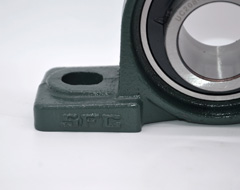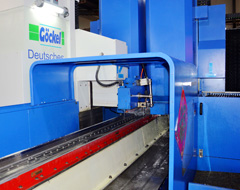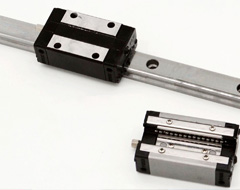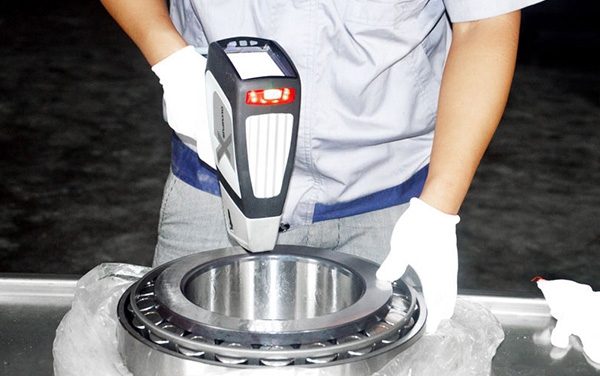Bearing equipment occupies machinery space and position
In mechanical design, generally determine the size of the shaft, and then select the rolling bearing according to the size of the shaft. Ball bearings are usually used for small shafts and roller bearings are used for large shafts. However, when the bearing is limited in the diameter direction of the machine, needle roller bearings, extra-light and ultra-light series ball or roller bearings are used; when the axial position of the bearing is limited in the machine, narrow or special Narrow series of ball or roller bearings.
The size, direction and nature of the load on the ball bearing
Load is the most important factor in bearing selection. Roller bearings are used to bear heavy loads, ball bearings are used to bear light or medium loads, and bearings made of carburized steel or bainite hardened can withstand shock and vibration loads.
In the direction of the load, when bearing pure radial load, you can choose deep groove ball bearings, cylindrical roller bearings or needle roller bearings. When bearing a small pure axial load, a thrust ball bearing can be used; when bearing a large pure axial load, a thrust roller bearing can be used. When the bearing bears combined radial and axial loads, angular contact ball bearings or tapered roller bearings are generally used. For cantilever support structures, tapered roller bearings or angular contact ball bearings are often used and are used in pairs.
Self-aligning performance of bearings
When the centerline of the shaft is different from the centerline of the bearing housing, there is an angular error, or the rigidity of the shaft is small due to the large distance between the two supports of the shaft, and it is easy to bend or tilt under force, you can choose a good adjustment Heart ball or spherical roller bearings, and outer ball bearings. This type of bearing can maintain normal operation when the shaft is slightly inclined or bent.
Bearing rigidity
The rigidity of the bearing refers to the amount of force required for the bearing to deform per unit. The elastic deformation of rolling bearings is very small, which can be ignored in most machines, but in some machines, bearing rigidity is an important factor. Generally, cylindrical and tapered roller bearings should be used. Because these two types of bearings are under point load, their rolling bodies and raceways are in point contact, and their rigidity is poor.
In addition, various types of bearings can also be pre-tensioned to achieve the purpose of increasing the support rigidity. Such as angular contact ball bearings and tapered roller bearings, in order to prevent the vibration of the shaft and increase the support rigidity, a certain axial force is often applied in advance during installation to make them compact.
Bearing speed
Each bearing model has its own limit speed, which is determined by physical characteristics such as size, type and structure. The limit speed refers to the maximum working speed of the bearing (usually r ∕ min). As a result, the bearing temperature rises, the lubricant dries up, and even the bearing gets stuck.
The speed range required in the application occasion helps to determine what type of bearing to use. D is the bearing size, which usually refers to the pitch circle diameter of the bearing. When selecting a bearing, use the average value of the bearing inner diameter and outer diameter, in mm. Multiply the pitch circle diameter D by the shaft rotation speed (unit r / min) to obtain a limiting speed factor (DN). DN is very important when selecting the bearing type and size. Most bearing manufacturers' product catalogs provide the limit speed value of their products. Practice has proved that it is better to work under the condition of 90% lower limit speed.
Bearing travel and axial displacement
Normally, a shaft is supported by two bearings separated by a certain distance. In order to adapt to the different degrees of thermal expansion of the shaft and the casing, one bearing should be fixed in the axial direction during installation, and the other bearing should be able to swim on the shaft (ie, floating support) to prevent the shaft from expanding or contracting Stuck phenomenon caused. Traveling bearings usually use cylindrical roller bearings (formerly 2000 and 32000) and needle roller bearings with no ribs in the inner ring or outer ring. This is mainly because the internal structure of such bearings allows the shaft and housing to have proper axial displacement. . At this time, the inner ring and the shaft, the outer ring and the hole of the housing can be tightly matched. When non-separable bearings are used for swimming support, such as deep groove ball bearings and spherical roller bearings, the outer ring must be allowed to fit the outer shell hole, or the inner ring and shaft should be loosely fitted to make it axially Free to swim. Tapered roller bearings, spherical roller bearings and deep groove ball bearings are basically of the positioning type, and when used as non-positioning, loose fit installation is used. All thrust roller bearings are positioning bearings.
Facilitates bearing installation and disassembly
When choosing a bearing type, whether it is convenient to install and remove the bearing must also be considered comprehensively, especially for the installation and removal of large and extra large bearings. General angular contact ball bearings, tapered roller bearings, cylindrical roller bearings and needle roller bearings with separable outer ring are easy to install and disassemble. Their inner and outer rings can be installed on the shaft or the housing hole, respectively. In addition, self-aligning roller bearings, double-row cylindrical roller bearings and self-aligning ball bearings with tapered bores and tapered sleeves on the inner diameter are also easier to install and remove.
other request
In addition to the above factors, the working environment temperature of the bearing, bearing seal, and special requirements for friction torque, vibration, noise, etc. should also be considered.

































